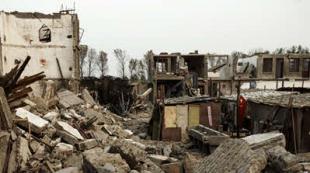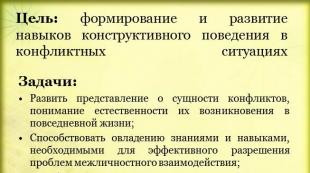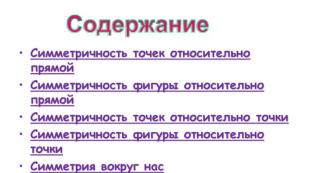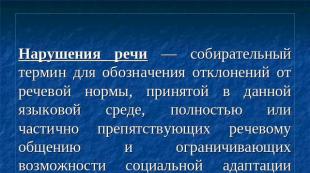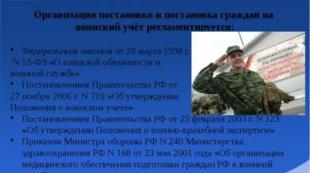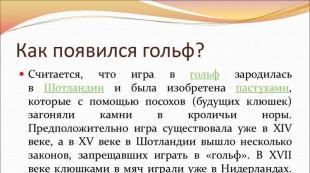Presentation pedagogical communication communication techniques. Presentation on the topic "pedagogical communication". Ethics in the teaching profession


Pedagogical skill Creative application in close connection of pedagogical knowledge, pedagogical experience and pedagogical technique based on love for children. Creative application in close connection of pedagogical knowledge, pedagogical experience and pedagogical technique based on love for children. The high professionalism of the teacher is manifested in his ability to teach all children. The high professionalism of the teacher is manifested in his ability to teach all children.

Pedagogical technique Pedagogical technique is based on the psychology of communication. The basis of pedagogical technique is the psychology of communication. In order to master specific pedagogical skills, it is necessary to understand their psychological mechanisms. In order to master specific pedagogical skills, it is necessary to understand their psychological mechanisms. To master the pedagogical technique, you need to master the psychology of communication. To master the pedagogical technique, you need to master the psychology of communication.

Communication functions: information information contact - a state of mutual readiness to receive and transmit educational information and maintain relationships in the form of constant mutual orientation; contact - the state of mutual readiness to receive and transmit educational information and maintain relationships in the form of constant mutual orientation; incentive - stimulation of the student's activity, directing him to perform certain educational actions; incentive - stimulation of the student's activity, directing him to perform certain educational actions; emotive - inducing the necessary emotional experiences in the student ("exchange of emotions"), as well as changing his own experiences and states with it, etc. emotive - inducing the necessary emotional experiences in the student ("exchange of emotions"), as well as changing his own feelings and states, etc.

Characteristics of communication (according to Klimov E. A.): The ability to lead, teach, educate, "perform useful actions to serve the various needs of people." The ability to listen and listen. Broad outlook. Speech (communicative) culture. "The soulful orientation of the mind, observation to the manifestations of feelings, mind and character of a person, to his behavior, the ability to mentally model the inner world, and not ascribe to it his own or another, familiar from experience." "A design approach to a person based on the belief that a person can always become better." The ability to empathize. Observation, etc.




Properties of communication According to the American psychotherapist E. Bern, there are three "I" in a person: Child (dependent, subordinate and irresponsible being) Child (dependent, subordinate and irresponsible being) Parent (on the contrary, independent, not subordinate and taking responsibility not only for himself but also for others). Parent (on the contrary, independent, not subordinate and taking responsibility not only for himself, but also for others). Adult (who knows how to reckon with the situation, remember the interests of others and distribute responsibility between himself and others.) Adult (who knows how to reckon with the situation, remember the interests of others and distribute responsibility between himself and others.)

Properties of communication Primitive level Primitive level Manipulative level Manipulative level Standardized level Standardized level Conventional level Conventional level Business level Business level Game level Game level Spiritual level Spiritual level






Models of pedagogical communication The educational and disciplinary model of communication is an authoritarian style of communication, where: Ways of communication: instructions, explanations, prohibitions, demands, threats, punishments, notations, shouting. Communication tactics: dictate or guardianship. Personal position: meet the requirements of management and supervisory authorities.


Personality-oriented model of communication The formation of knowledge, skills and abilities is not a goal, but a means of the full development of the individual. Ways of communication: understanding, recognition and acceptance of the personality of the child, based on the ability to decenter that is emerging in adults (the ability to take the position of another, take into account the point of view of the child and not ignore his feelings and emotions). Ways of communication: understanding, recognition and acceptance of the personality of the child, based on the ability to decenter that is being formed in adults (the ability to take the position of another, take into account the point of view of the child and not ignore his feelings and emotions). Communication tactics: cooperation, creation and use of situations that require the manifestation of intellectual and moral activity of children. Communication tactics: cooperation, creation and use of situations that require the manifestation of intellectual and moral activity of children. Personal position of the teacher: proceed from the interests of the child and the prospects for his further development. Personal position of the teacher: proceed from the interests of the child and the prospects for his further development.

In social psychology, it is customary to distinguish three main aspects of communication (Andreeva G.M.): mutual perception and understanding of each other by people (perceptual aspect of communication) - adequate assessment of the individual characteristics of children, their interests, inclinations, moods; information exchange (communicative aspect); implementation of joint activities (interactive aspect).

Mechanisms of interpersonal perception projection (unconscious tendency to attribute to others their own motives, experiences, qualities); projection (unconscious tendency to attribute to others their own motives, experiences, qualities); decentration (the ability of a person to move away from his own egocentric position, the ability to perceive the point of view of another person); decentration (the ability of a person to move away from his own egocentric position, the ability to perceive the point of view of another person); identification (unconscious identification of oneself with another or conscious mental putting oneself in the place of another); identification (unconscious identification of oneself with another or conscious mental putting oneself in the place of another); empathy (comprehension of the emotional states of another person in the form of empathy); empathy (comprehension of the emotional states of another person in the form of empathy); stereotyping (mechanism of interpersonal cognition). stereotyping (mechanism of interpersonal cognition).

Socio-perceptual stereotypes: Anthropological - assessment of the internal, psychological qualities of a person, assessment of his personality depends on the characteristics of his physical appearance. Ethno-national - the psychological assessment of a person is mediated by his belonging to a particular race, nation, ethnic group. Socio-status - an assessment of the personal qualities of a person from his social status. Socio-role - assessment of a person from his social role. Expressive-aesthetic - assessment of a person from the external attractiveness of a person (beauty effect). Verbal-behavioral - personality assessment from external features (expressive features, features of speech, facial expressions, etc.).

Psychological conditions of the ability to convince Put a psychological problem. Set a psychological problem. Convince yourself of what you convince. Convince yourself of what you convince. Choose logic. Choose logic. Find arguments. Find arguments. Pick out opposing points of view and confront them. Pick out opposing points of view and confront them. Summarize. Summarize. Make a conclusion. Make a conclusion. 26 1. What would you take with you to a desert island? 2. If you had to turn into an animal and you could choose which one, what would you be? 3. What is your favorite proverb, saying or aphorism? 4. Continue the sentence: “When they shout at me, I ...” 5. What quality in a person is very unpleasant for you? 6. What would you do with the winnings of one million rubles? 7. If you could choose, how old would you be? 8. What can't money buy? 9. What personality trait would you like to get rid of? 10. Complete the sentence: “When I become a teacher, I will ...” Answer the following questions in writing:


- and vtocratic (autocratic leadership style), when the teacher exercises sole control over a team of students
- authoritarian (powerful) style of leadership allows for the opportunity for students to participate in the discussion of issues of academic or collective life
- democratic style involves the attention and consideration of students' opinions by the teacher
- ignoring style is characterized by the fact that the teacher seeks to interfere as little as possible in the life of students
- conniving, conforming style is manifested when the teacher is removed from the leadership of a group of students
- inconsistent, illogical style - the teacher, depending on external circumstances and his own emotional state, implements any of the named leadership styles

Styles of pedagogical communication classification (psychologist V.A. Kan-Kalik):
1. Communication based on high professional attitudes of the teacher
2. Communication based on friendship
3. Communication-distance
4. Communication-intimidation
5. Communication-flirting

Teacher Behavior Models
- Model dictatorial "Mont Blanc" - the teacher is, as it were, removed from the students being trained
Consequence: lack of psychological contact, and hence the lack of initiative and passivity of the students being trained .
- Non-contact model ("Chinese wall") there is little feedback between teacher and students
Consequence : weak interaction with the students being trained, and on their part - an indifferent attitude towards the teacher.
- Model of differentiated attention ("Locator") The teacher is not focused on the entire composition of the audience, but only on a part
Consequence : the integrity of the interaction in the system of a teacher - a team of students is violated, it is replaced by the fragmentation of situational contacts

Hyporeflex model ("Teterev") the teacher in communication is, as it were, closed on himself
Consequence : there is practically no interaction between the trainees and the trainer, and a field of psychological vacuum is formed around the latter
Model of active interaction ("Union") - the teacher is constantly in dialogue with the students
Consequence : emerging educational, organizational and ethical problems are creatively solved by joint efforts. This model is the most productive.

Interaction features
- constructive
- organizational
- communicative and stimulating
- information and training
- emotionally corrective
- control and evaluation

Reasons preventing pedagogical communication
- the teacher does not take into account the individual characteristics of the student, does not understand him and does not strive for this;
- the student does not understand his teacher and therefore does not accept him as a mentor;
- the actions of the teacher do not correspond to the reasons and motives of the student's behavior or the current situation;
- the teacher is arrogant, hurts the student's pride, humiliates his dignity;
- the student consciously and stubbornly does not accept the requirements of the teacher or, more seriously, of the entire team .

- NEEDS and communication skills
- ability to empathize and understand people
- FLEXIBILITY
- Ability to support FEEDBACK
- ability to MANAGE YOURSELF
- ability to SPONTANCY
- ability to FORECAST
- VERBAL ABILITIES
- mastery of the art of PEDAGOGICAL EXPERIENCE
- ability for PEDAGOGICAL IMPROVISATION

Think about your relationships with other people, build them on mutual understanding and trust. When communicating with a person, never get hung up on achieving your specific goals and objectives. Do not forget that the child, his interests, aspirations, his present and future are the meaning of your work. Learn to see in every person, child, what distinguishes him from others, that “zest” that makes him unique, unrepeatable. When you come to a person, leave your problems, ambitions, stereotypes. Talking to a person, communicate with him, and not with his official status, your idea of him. The need for equality is inherent in everyone, and even more so in children. Learn to see yourself as if from the outside, through the eyes of other people, analyze how you behaved while communicating with them, strive to put yourself in the place of the person with whom you communicate. Smile at people more often. Smiling has others around you, creates a favorable emotional mood, and makes others want to communicate with you. Develop your inner spiritual world, your talents and abilities. Remember that a creative, spiritually rich person always attracts other people, especially when all this is combined with sensitivity, the ability to understand others.


















1 of 18
Presentation on the topic: Technology of pedagogical communication
slide number 1

slide number 2

Description of the slide:
The concept of communication Communication is one of the most common categories that have been described in philosophical, sociological, and psychological-pedagogical literature. BF Lomov considers communication as a specific form of human interaction with other people, during which a mutual exchange of ideas, ideas, interests, moods, attitudes is carried out.
slide number 3

Description of the slide:
Communication and activity Historically, communication between people arose and developed, first of all, directly in joint labor activity. In most cases, interpersonal communication is woven into this or that activity, acts as its essential and integral attribute, an important condition for its success. The type and nature of the activity served by communication has a certain influence on the content, form and features of the flow of the process of communication between its participants.
slide number 4

Description of the slide:
Communication and attitude The concept of "communication" is closely related to the concept of "relationship". These concepts must be considered in conjugation, since relationships are manifested and formed, first of all, directly in communication. At the same time, the relations that have developed between partners have a significant impact on the process of communication between them.
slide number 5

Description of the slide:
slide number 6

Description of the slide:
Professional and pedagogical communication Pedagogical communication is a professional communication of a teacher with students in the classroom or outside it (in the process of teaching and education), which has certain pedagogical functions and is aimed (if it is full and optimal) at creating a favorable psychological climate, as well as at another kind psychological optimization of educational activities and relations between the teacher and students and within the student team
slide number 7

Description of the slide:
The goals of professional and pedagogical communication According to the goals, communication can be divided into biological and social in accordance with the needs it serves (R.S. Nemov): Biological communication is aimed at meeting biological needs, maintaining, preserving and developing the human body. Social communication is aimed at satisfying cognitive , creative, aesthetic, moral and other purely human needs.
slide number 8

Description of the slide:
Functions of professional and pedagogical communication Informative Educational Function of people knowing each other Function of organizing and servicing one or another subject activity Realization of the need for contact with another person Function of introducing the partner to the experience and values of the initiator of communication Function of introducing the initiator of communication to the values of the partner Function of opening the child to communication Function of complicity Function elevation of the student's personality
slide number 9

Description of the slide:
The content of professional-pedagogical communication The content of communication is usually understood as the information that in interindividual contacts is transmitted from one subject to another or circulates between them. Since this information is far from homogeneous in nature, material, cognitive, conditioning, motivational and activity communication are distinguished by content (R.S. Nemov).
slide number 10

Description of the slide:
The structure of professional and pedagogical communication In the structure of pedagogical communication, a number of stages can be distinguished: 1. Modeling by the teacher of the upcoming communication with the class, with another other audience in the process of preparing for direct activities with children or adults (prognostic stage) .2. Organization of direct communication with the class, the audience at the time of the initial interaction with them (the initial period of communication).3. Communication management in the developing pedagogical process.4. Analysis of the implemented communication system and modeling of the communication system of the forthcoming activity.
slide number 11

Description of the slide:
Means of professional and pedagogical communication Another important characteristic of communication is the means of communication, which can be represented as a means of transmitting information and expressing relations between partners in the process of their interaction. Depending on the means, communication can be direct and indirect, direct and indirect, verbal and non-verbal.
slide number 12

Description of the slide:
Features of the professional position and styles of pedagogical influence Five main types of professional positions of the teacher can be identified: The teacher can see his main task in being a source of necessary and useful information for his students. The teacher can appear before the students in the role of a person who vigilantly monitors the order in the class, in the role of a kind of overseer. The teacher can take the position of the guardian of his students The position of non-interference The position of the elder comrade, the wise and caring friend and mentor of the students For teachers who are characterized by an authoritarian style, the suppression of their students by categorical, unquestioning judgments, and arrogance in the ways of issuing orders and instructions is characteristic. For teachers who are guided by a democratic style of leadership, it is typical to strive to rely on the opinions of their wards, to take into account their interests, desires and characteristics, to tactfully and correctly resolve all emerging issues and contradictions with them. Representatives of the liberal style of pedagogical leadership are characterized by the desire to avoid conflict situations, from clashes with others, including their students.
slide number 13

Description of the slide:
Social roles of subjects of professional and pedagogical communication Formal roles. A formal role is understood as a line of behavior that a person builds in accordance with the expectations of society he has learned when performing a specific social function. intragroup roles. An intra-group role is understood as a line of conduct that a person builds with members of a particular group based on the relationships that have developed in it. interpersonal roles. An interpersonal role is a line of behavior that we build in communication with a familiar person based on the relationship that has developed between us. individual roles. An individual role is understood as the behavior that a person builds in accordance with his own expectations. "Role fan". current role. Each of us has a fairly rich set of different social roles that can be represented as a kind of "role fan". Some petals of this "fan" can correspond to various formal roles, others to intragroup roles, others to interpersonal roles, and fourth to individual ones, for example: Director Competent specialist Courageous and determined person Cheerful storyteller Friend Savior Leader
slide number 14

Description of the slide:
Levels of communication between teachers and schoolchildren Primitive level. When communicating at a primitive level, at least one of its participants (and possibly both) asks simple questions, the main thing that interests the author of such questions is who is stronger: he or his communication partner? Depending on this, the tactics of interaction with the interlocutor is chosen, and, as a rule, also quite primitive. manipulative level. At the manipulative level, at least one of the partners is trying to resort to various tricks and tricks in order to obtain some benefit for himself. standardized level. The standardized level of communication is otherwise known as mask contact. When communicating at this level, at least one of the partners seeks to hide his true state, as if to hide his face behind an imaginary mask. Conventional level. Communication partners can reach a certain agreement, as if to conclude a convention on the rules of communication and adhere to these conditional rules when interacting. If this happens, then the communication is said to be carried out at a conventional level. Game level. At the game level, a person wants to be interesting for his partner, he wants to impress him, to please him. business level. At the business level, external attributes are not so important for partners; his business or mental activity, competence in jointly resolved issues, and the ability to do business come to the fore here. Spiritual level. Communication at this level is characterized by a certain aspiration of partners to each other, a desire to see a partner, talk to him, ask him questions, share innermost thoughts, and do something important for him. The multilevel nature of communication lies in the fact that in real life situations, partners usually do not think about the level at which their communication proceeds. In addition, this process, as a rule, is carried out not at one, but at several levels. At the same time, one of the partners may not be interested in informing the other about his true intentions.
Description of the slide:
Ways to resolve conflicts Conflict resolution is a creative process, then we can only talk about a certain sequence of conditional steps that allow us to understand the features of contradictions and processes between the conflicting parties, outline real actions to reduce tension between them, predict the creation and resolution of conflict situations. Conflict detection Analysis of the features of the course and development of the conflict Direct conflict resolution Ways: Humor Recognition of merits Compromise Arbitration court
slide number 17

Description of the slide:
Manipulations in communication between teachers and students. Types of manipulations Depending on the complexity of manipulative techniques, simple and complex manipulations can be distinguished. Simple manipulations are a small action or a simple system of manipulative techniques. Such manipulations are started in order to distract the communication partner from an undesirable problem for the manipulator, to switch his attention to another object. Complex manipulations are a rather subtle game, a rather skillful interweaving of various manipulative techniques. The main purpose of the manipulation is carefully hidden. Selfish manipulations are aimed at obtaining by the manipulator a certain material benefit for themselves. Disinterested (harmless) manipulations are obvious actions where the manipulator does not really try to hide his goals, his desire to get a certain gain. Noble manipulations are actions by which the manipulator pursues noble goals.
slide number 18

Description of the slide:
Characteristic features of some manipulators 1. Dictator. A manipulator of this type seeks to show his communication partner his strength, his power, his authority, his high patrons. 2. Rag. Manipulation is based on the fact that the manipulator presents himself as a victim of the Dictator. The manipulator demonstrates to everyone around him and to a specific communication partner that he is, in fact, a normal person, a good student or worker. He usually gets everything. But in this situation, he could not work well because of Dictator Ivanov. 3. Calculator. The essence of manipulation lies in the fact that the manipulator deliberately exaggerates the importance of strict adherence to the established order, certain rules and instructions. 4. Sticky. This manipulator demonstrates by all means that he is a victim of circumstances. He is an unhappy man who is constantly unlucky in life. 5. Bully. He deliberately demonstrates hostility to his partner, he can use threats, insults and rudeness to escalate tension in communication. 6. Nice guy. This manipulator shows you his attentiveness, care and love, in the expectation that you will repay him the same. 7. Judge. This manipulator appears before the partner as an omniscient critic, unceremonious accuser and accuser. 8. Protector. In his behavior, he focuses on consoling a partner who has made a mistake or is in an unpleasant situation. If the partner listens to the advice of the Defender and follows his recommendations, then this will be a psychological gain for the manipulator. And if the partner also promises not to forget the sensitivity and care of the Defender, then the latter may well count on receiving material rewards for his sensitivity.


Communication functions
Characteristic
Informational
Messaging, i.e. reception and transmission of any information in response to a request, as well as the exchange of views.
Contact
Establishing contact as a state of mutual readiness to receive and transmit messages.
Incentive
Stimulation of the activity of a communication partner, directing him to perform certain actions.
Coordinating
Mutual orientation and coordination of actions in the organization of joint activities.
Understanding
Not only adequate perception and understanding of the meaning of the message, but also understanding by partners of each other.
Establishing Relationships
Awareness and fixation of one's place in the system of role-playing, business, interpersonal relations of the community in which the teacher has to act.

- Authoritarian (smashing arrows). The teacher single-handedly determines the direction of the group's activities, indicates who should work with whom, suppresses any initiative of students, students live in a world of conjectures. The main forms of interaction are an order, an indication, an instruction, a reprimand.
- Democratic (returning boomerang). It manifests itself in the support of the leader on the opinion of the team, the teacher tries to convey the goal of the activity to the consciousness of everyone. The main ways of communication with such a teacher are request, advice, information.
- Liberal (floating raft). The teacher tries not to interfere in the life of the team, does not show activity, considers questions formally, easily obeys other conflicting influences.

- Communication based on passion for joint activities.
- Communication based on friendship.
- Communication-dialogue.
- Communication is distance.
- Communication is intimidation.
- Communication-flirting.

model name
characteristic
1. Announcer model ("Mont Blanc").
consequence
Pedagogical functions are reduced to information communication in the absence of personal interaction.
2. Non-contact model ("Chinese wall").
lack of psychological contact, lack of initiative and passivity of trainees.
There is a weak feedback between the teacher and the student due to communication barriers: lack of desire for cooperation, informational rather than interactive nature of the lesson.
3. Model of differentiated attention ("Locator")
4. Hyporeflexive model ("Teterev").
weak interaction with students, and on their part - an indifferent attitude towards the teacher.
Based on selective relationships with students. Teachers are not focused on the entire composition of the audience, but only on a part, for example, on talented, weak, leaders.
the integrity of the interaction in the "teacher-team" system is violated, it is replaced by the fragmentation of situational contacts.
The teacher in communication is, as it were, closed in on himself: his speech is mostly monologue. Such a teacher shows emotional deafness to others.
5. Hyper-reflexive model ("Hamlet").
there is practically no interaction between the student and the teacher (the field of psychological vacuum).
The teacher is concerned not so much with the content side of the interaction as with how it is perceived by others. Interpersonal relationships take on a dominant role for him.
heightened socio-psychological sensitivity of the teacher, leading him to inadequate reactions to the audience's remarks and actions; the reins of power may be in the hands of the trainees.
model name
characteristic
6. Model of inflexible response ("Robot").
The relationship between the teacher and the students is built according to a rigid program, but the teacher does not have a sense of the constantly changing situation of communication. They do not take into account the composition and psychological state of the trainees, their age and ethnic characteristics.
consequence
The educational process is entirely focused on the teacher. He is the main and only protagonist. Questions and answers, judgments and arguments come from him.
8. Model of active interaction ("Soyuz").
low effect of social interaction.
The teacher is constantly in dialogue with the students, keeps them in a positive mood, encourages initiative, easily grasps changes in the psychological climate of the team and responds flexibly to them. The style of friendly interaction prevails while maintaining role distance.
lack of initiative is brought up, the creative nature of learning is lost, the motivational sphere of cognitive activity is distorted.
Consequence: emerging educational, organizational, ethical and other problems are creatively solved by joint efforts. This model is the most productive.




- Timely assistance in the selection of adequate vocabulary, correct
construction of statements;
- Training in communication techniques, performance and communication techniques;
- Positive criticism (if necessary) of the student's behavior in dialogue with the teacher;
- Demonstration by verbal and non-verbal means of interested attention to students, support for their desire to participate in a dialogue with the teacher.

- Encouragement to actively interact with the teacher in the classroom;
- Motivation in front of a group of rewards for the initiative shown;
- Criticism of one's own mistakes as a demonstration of the standard of attitude towards them;
- "Game provocation".

The choice by students of the personal qualities of the teacher.
- Justice
- The ability to put yourself in the place of another
- Kindness
- Restraint
- Tolerance
- Beauty, style
- Good verbal ability
- Availability of the presentation of the material
- severity
- Interest in people and working with them; Flexibility, operational and creative thinking; Ability to perceive and maintain feedback in communication; The ability to manage oneself; Empathy (the ability to put yourself in the place of another); Ability to communicate spontaneously; The ability to predict possible pedagogical situations, the consequences of their influences; Good verbal abilities: culture, development of speech, rich vocabulary, correct selection of language means; The ability for pedagogical improvisation, the ability to apply the whole variety of means of influence (persuasion, suggestion, the use of various methods of influence)
- Interest in people and working with them;
- Flexibility, operational and creative thinking;
- Ability to perceive and maintain feedback in communication;
- The ability to manage oneself;
- Empathy (the ability to put yourself in the place of another);
- Ability to communicate spontaneously;
- The ability to predict possible pedagogical situations, the consequences of their influences;
- Good verbal abilities: culture, development of speech, rich vocabulary, correct selection of language means;
- The ability for pedagogical improvisation, the ability to apply the whole variety of means of influence (persuasion, suggestion, the use of various methods of influence)

